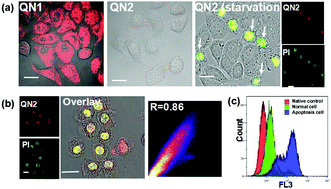当前位置:
X-MOL 学术
›
J. Mater. Chem. B
›
论文详情
Our official English website, www.x-mol.net, welcomes your
feedback! (Note: you will need to create a separate account there.)
Real-time noninvasive monitoring of cell mortality using a two-photon emissive probe based on quaternary ammonium†
Journal of Materials Chemistry B ( IF 6.1 ) Pub Date : 2018-06-11 00:00:00 , DOI: 10.1039/c8tb00976g Mingzhu Zhang 1, 2, 3 , Wei Du 1, 2, 3 , Xiaohe Tian 2, 3, 4 , Ruilong Zhang 5, 6, 7 , Meng Zhao 1, 2, 3 , Hongping Zhou 1, 2, 3 , Yaqi Ding 3, 8, 9 , Lin Li 3, 8, 9 , Jieying Wu 1, 2, 3 , Yupeng Tian 1, 2, 3, 10, 11
Journal of Materials Chemistry B ( IF 6.1 ) Pub Date : 2018-06-11 00:00:00 , DOI: 10.1039/c8tb00976g Mingzhu Zhang 1, 2, 3 , Wei Du 1, 2, 3 , Xiaohe Tian 2, 3, 4 , Ruilong Zhang 5, 6, 7 , Meng Zhao 1, 2, 3 , Hongping Zhou 1, 2, 3 , Yaqi Ding 3, 8, 9 , Lin Li 3, 8, 9 , Jieying Wu 1, 2, 3 , Yupeng Tian 1, 2, 3, 10, 11
Affiliation

|
We report that a dicyanyl derivative QN2 containing quaternary ammonium was capable of identifying apoptotic cells by targeting nucleic acid (DNA and RNA) and we were able to observe nuclear ultra-details using a stimulated emission depletion (STED) nanoscopy technique. QN2 could evaluate the anti-cancer drug pesticide effect by monitoring in real-time without interfering with normal cell proliferation. These results suggest the high potential for using QN2 in practice for monitoring apoptosis to evaluate tumor therapy effectiveness or for drug development.
中文翻译:

使用基于季铵盐的双光子发射探针实时无创监测细胞死亡率†
我们报告说,含有季铵盐的二氰基衍生物QN2能够通过靶向核酸(DNA和RNA)来鉴定凋亡细胞,并且我们能够使用受激发射损耗(STED)纳米技术观察到核超细节。QN2可以通过实时监测来评估抗癌药农药的作用,而不会干扰正常的细胞增殖。这些结果表明在实践中使用QN2监测细胞凋亡以评估肿瘤治疗效果或药物开发的巨大潜力。
更新日期:2018-06-11
中文翻译:

使用基于季铵盐的双光子发射探针实时无创监测细胞死亡率†
我们报告说,含有季铵盐的二氰基衍生物QN2能够通过靶向核酸(DNA和RNA)来鉴定凋亡细胞,并且我们能够使用受激发射损耗(STED)纳米技术观察到核超细节。QN2可以通过实时监测来评估抗癌药农药的作用,而不会干扰正常的细胞增殖。这些结果表明在实践中使用QN2监测细胞凋亡以评估肿瘤治疗效果或药物开发的巨大潜力。











































 京公网安备 11010802027423号
京公网安备 11010802027423号